Study on Purification Technology of Silicon Carbide Crystal Growth Powder
Abstract
:1. Introduction
2. Experiment
3. Results and Discussion
3.1. Graphitization and Polytype Change
3.2. Impurity Changes in the Powder
4. Conclusions
Author Contributions
Funding
Institutional Review Board Statement
Informed Consent Statement
Data Availability Statement
Conflicts of Interest
References
- Liu, Y.L. Recent Progress on Single-Crystal Growth and Epitaxial Growth of 4H Silicon Carbide. Solid State Phemomena 2022, 332, 73–84. [Google Scholar] [CrossRef]
- Shin, D.-G.; Kim, B.-S.; Son, H.-R.; Kim, M.-S. Study on the growth of 4H-SiC single crystal with high purity SiC fine powder. J. Korean Cryst. Growth Cryst. Technol. 2019, 29, 383–388. [Google Scholar]
- Kim, S.-K.; Jung, E.Y.; Lee, M.-H. Defect-Induced Luminescence Quenching of 4H-SiC Single Crystal Grown by PVT Method through a Control of Incorporated Impurity Concentration. Compounds 2022, 2, 68–79. [Google Scholar] [CrossRef]
- Peng, Y.; Hu, X.; Xu, X.; Chen, X.; Peng, J.; Han, J.; Dimitrijev, S. Temperature and doping dependence of the Raman scattering in 4H-SiC. Opt. Mater. Express 2016, 6, 2725–2733. [Google Scholar] [CrossRef]
- Bauer, M.; Gigler, A.M.; Huber, A.J.; Hillenbrand, R.; Stark, R.W. Temperature-depending Raman line-shift of silicon carbide. J. Raman Spectrosc. 2009, 40, 1867–1874. [Google Scholar] [CrossRef]
- Wan, L.; Zhao, D.; Wang, F.; Xu, G.; Lin, T.; Tin, C.-C.; Feng, Z.; Feng, Z.C. Quality evaluation of homoepitaxial 4H-SiC thin films by a Raman scattering study of forbidden modes. Opt. Mater. Express 2018, 8, 119–127. [Google Scholar] [CrossRef]
- Luo, H.; Zhang, X.; Yang, D.; Pi, X. Research Progress on High-Purity SiC Powder for Single Crystal SiC Growth. J. Synth. Cryst. 2021, 50, 1562–1574. [Google Scholar]
- Najafi, A.; Golestani-Fard, F.; Rezaie, H.R. Improvement of SiC nanopowder synthesis by sol–gel method via TEOS/resin phenolic precursors. J. Sol-Gel Sci. Technol. 2015, 75, 255–263. [Google Scholar] [CrossRef]
- Acheson, E.G. Production of Artificial Crystalline Carbonaceous Materials. Switzerland Patent CH 6612A, 1893. [Google Scholar]
- Kwasnicki, P. Evaluation of Doping in 4H-SiC by Optical Spectroscopies. Ph.D. Thesis, Université Montpellier II—Sciences et Techniques du Languedoc, Montpellier, France, 2014. [Google Scholar]
- Zhuo, S.-Y.; Liu, X.-C.; Huang, W.; Kong, H.-K.; Xin, J.; Shi, E.-W. Photoluminescence in fluorescent 4H-SiC single crystal adjusted by B, Al, and N ternary dopants. Chin. Phys. B 2019, 28, 017101. [Google Scholar] [CrossRef]
- Zhuo, S.-Y.; Liu, X.-C.; Xu, T.-X.; Yan, C.-F.; Shi, E.-W. Strong correlation between B-Al-N doping concentration fluctuation and photoluminescence effects of β-SiC. AIP Adv. 2018, 8, 075130. [Google Scholar] [CrossRef] [Green Version]
- Deng, L.; Wang, X.; Hua, X.; Lu, S.; Wang, J.; Wang, H.; Wang, B. Purification of -SiC powders by heat treatment in vacuum. Adv. Compos. Hybrid Mater. 2021, 5, 431–437. [Google Scholar] [CrossRef]
- Gadalla, M.N.; Greenspon, A.S.; Defo, R.K.; Zhang, X.; Hu, E.L. Enhanced cavity coupling to silicon vacancies in 4H silicon carbide using laser irradiation and thermal annealing. Proc. Acad. Natl. Sci. USA 2021, 118, e2021768118. [Google Scholar] [CrossRef] [PubMed]
- Wang, C. Modification of plasma-generated SiC nanoparticles by heat treatment under air atmosphere. J. Alloys Compd. 2022, 900, 163507. [Google Scholar] [CrossRef]
- Calabretta, C.; Pecora, A.; Agati, M.; Privitera, S.; Muoio, A.; Boninelli, S.; la Via, F. Graphite Assisted P and Al Implanted 4H-SiC Laser Annealing. Mater. Sci. Forum 2022, 1062, 204–208. [Google Scholar] [CrossRef]
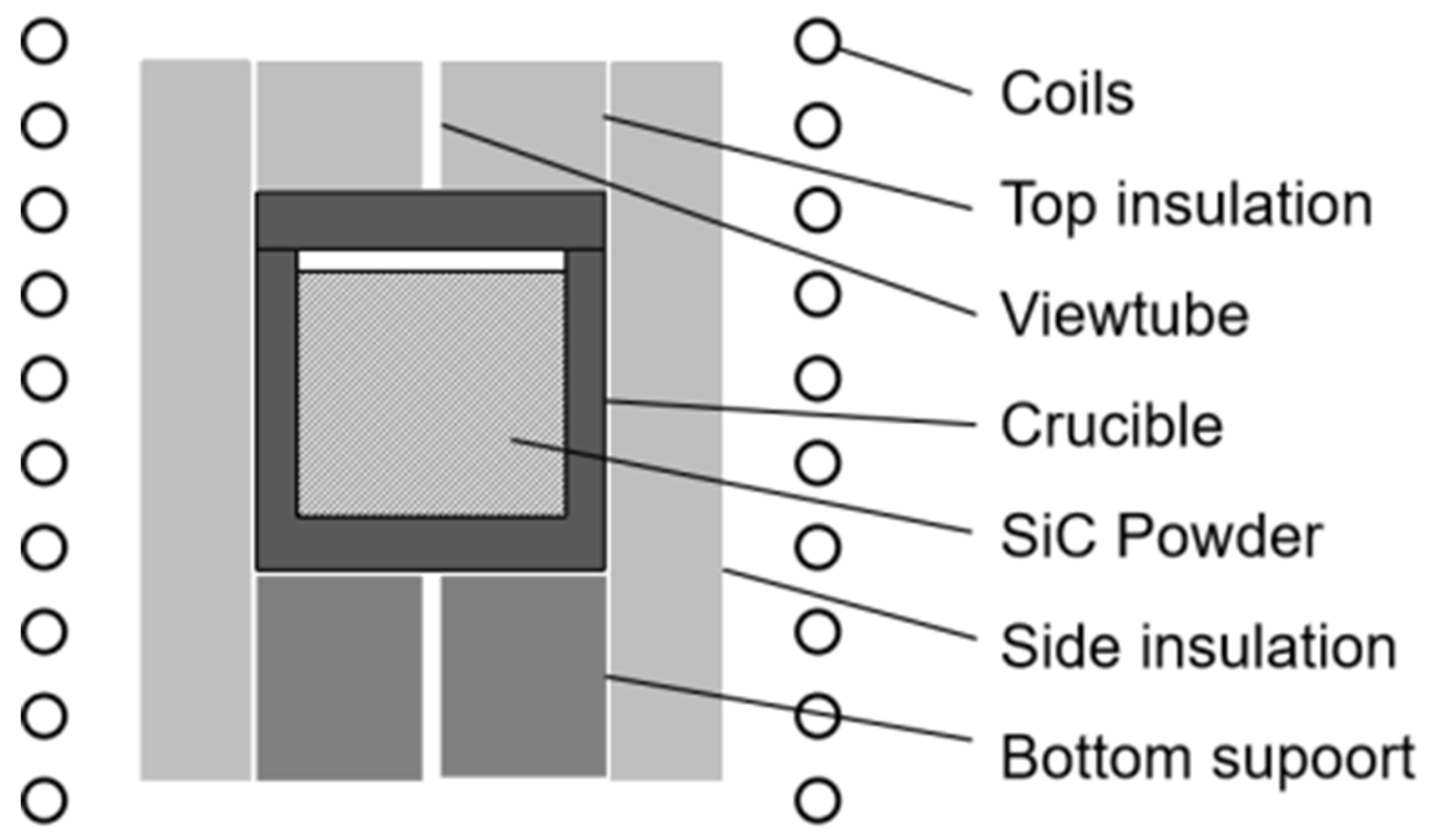
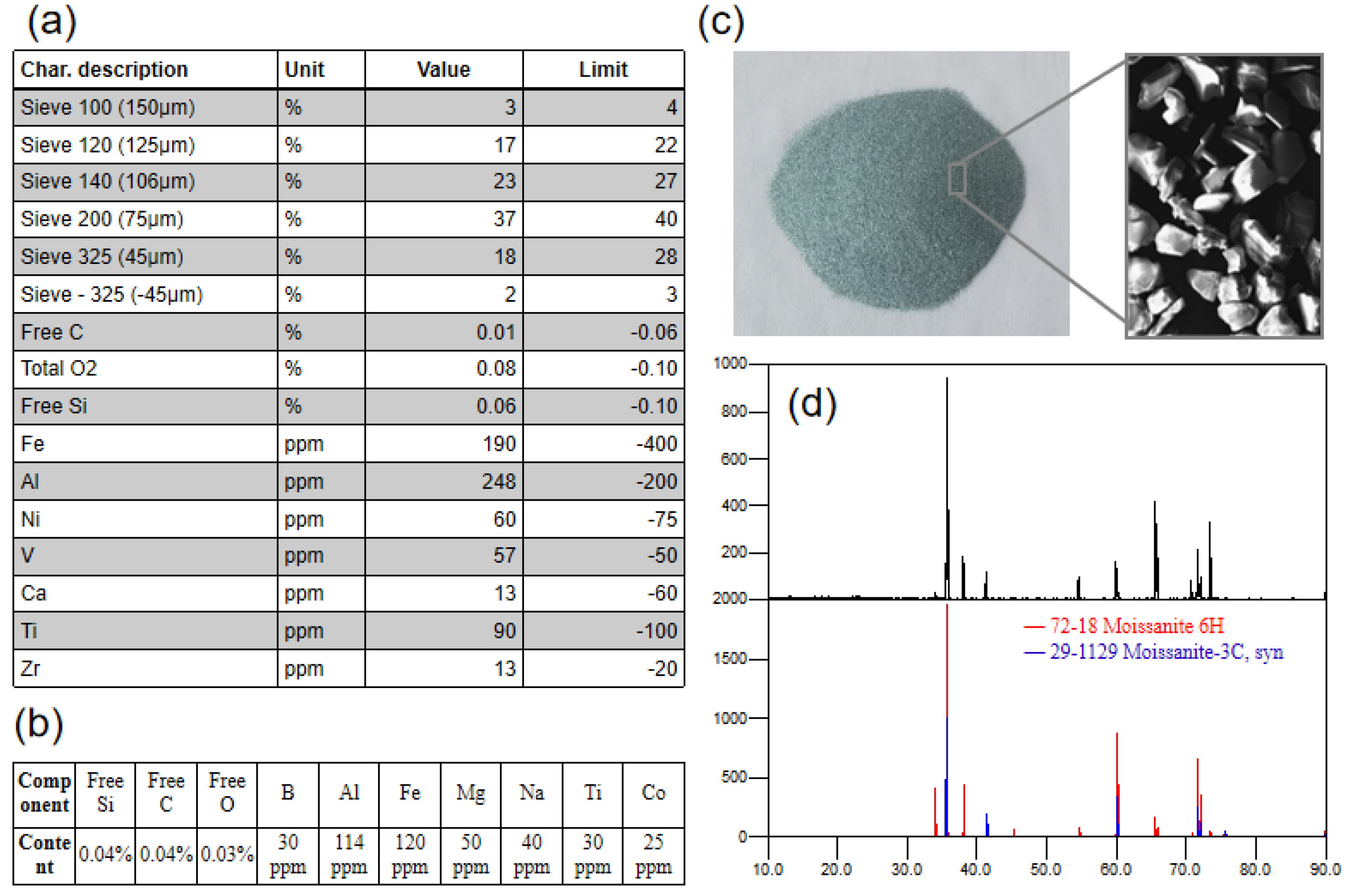
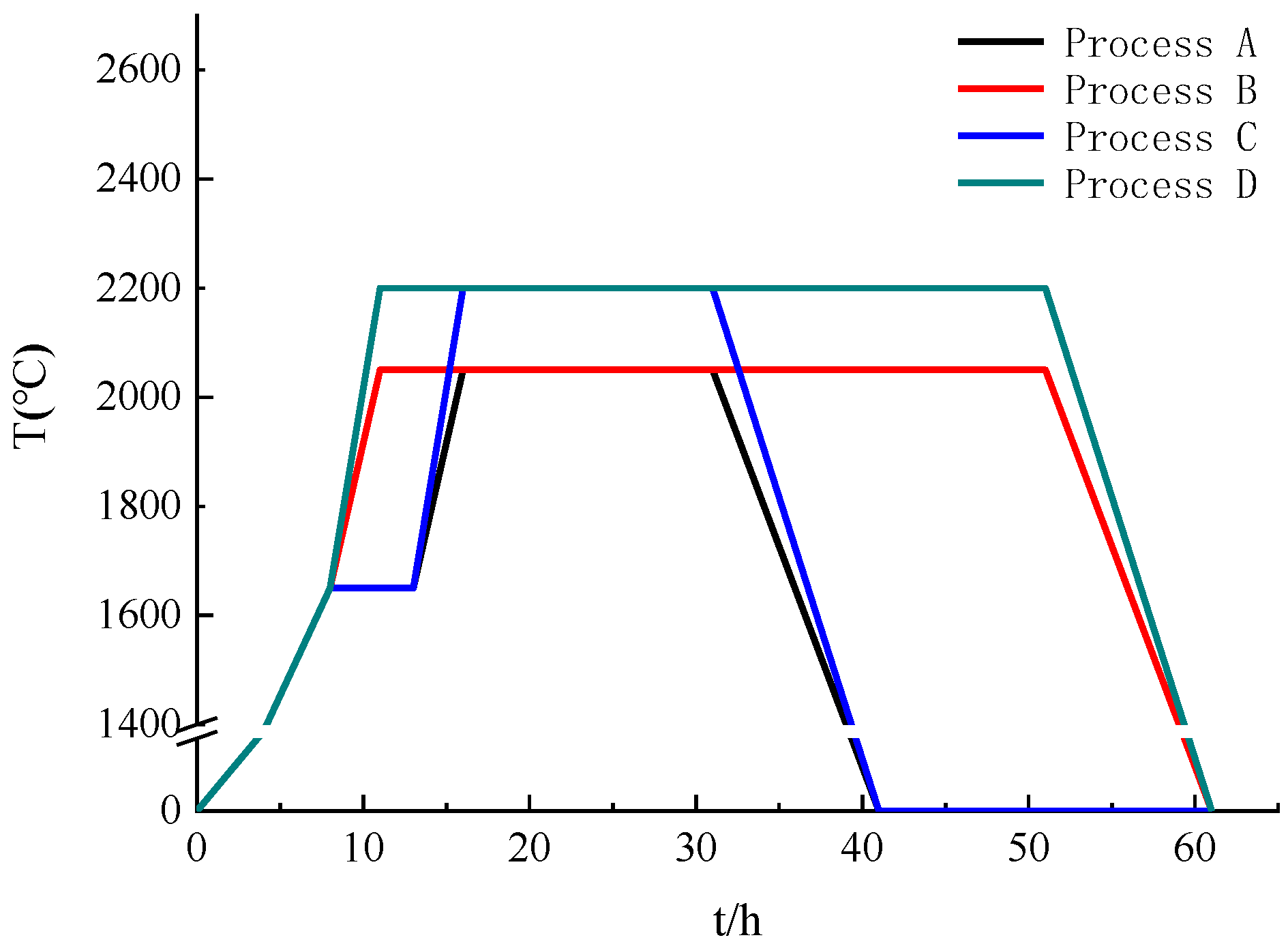
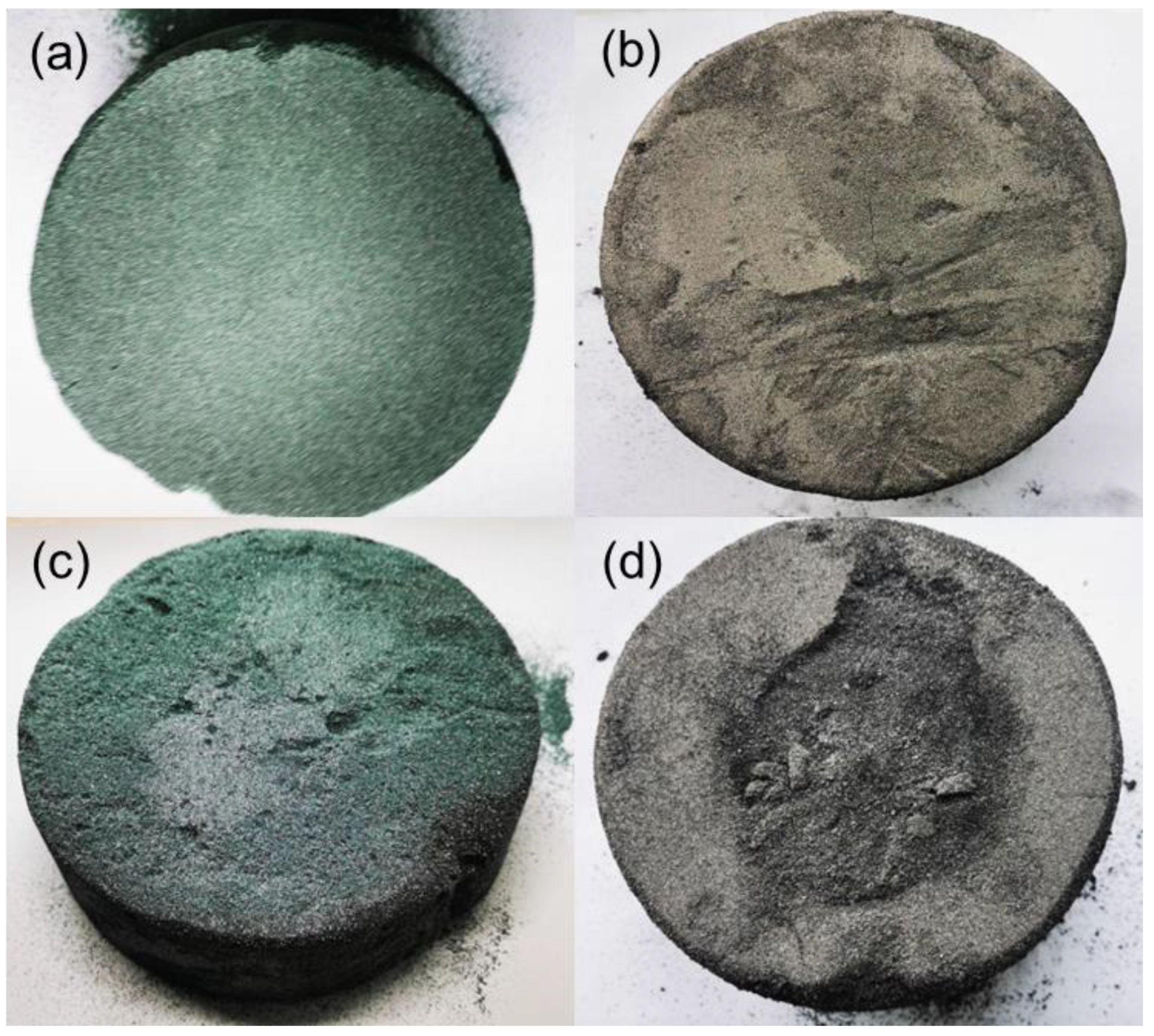
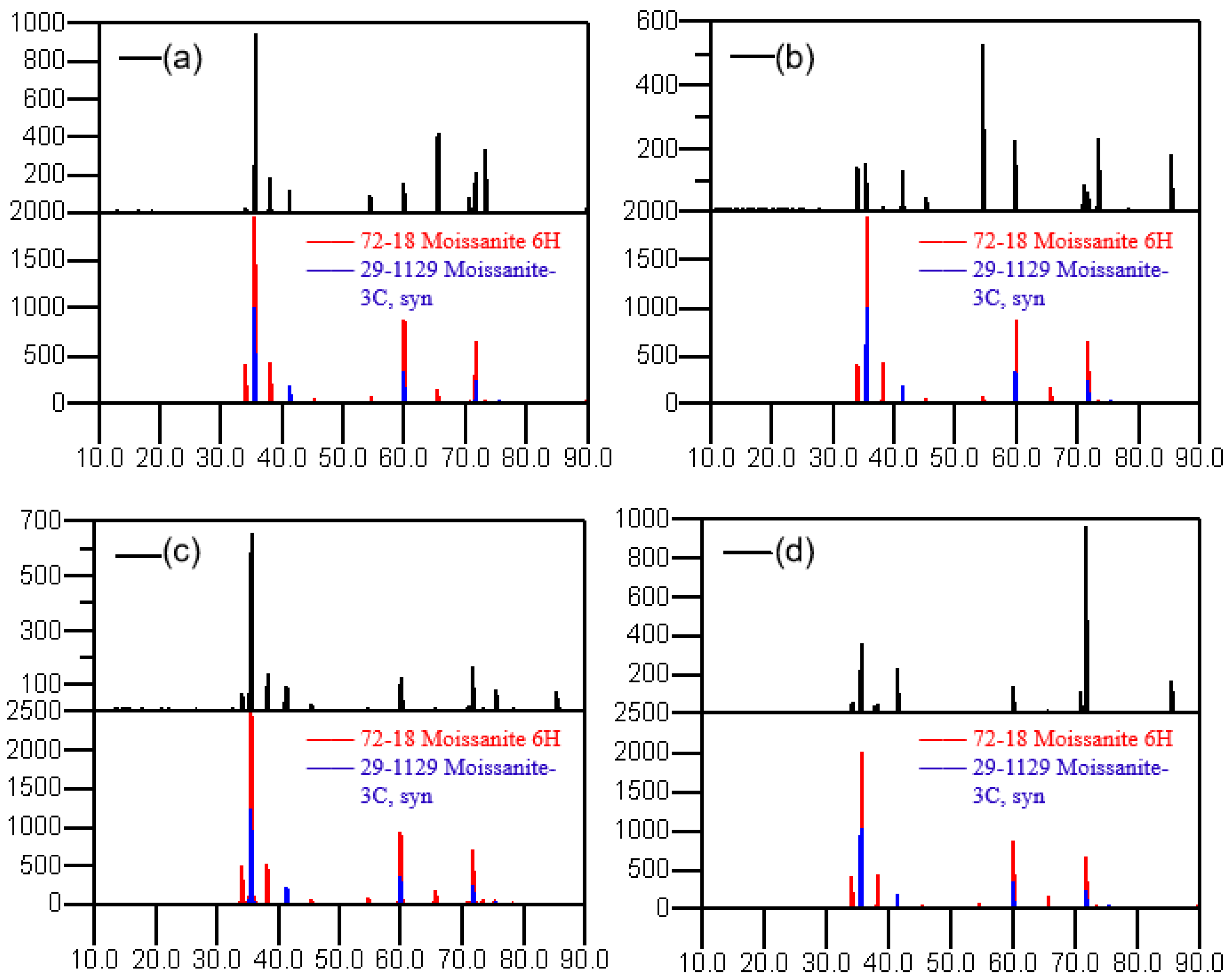

| Impurities | Original Powder | Powder after Process A | Powder after Process B | Powder after Process C | Powder after Process D |
|---|---|---|---|---|---|
| B | 30 ppm | 4.89 ppm | 0.48 ppm | 0.18 ppm | 2.71 ppm |
| Al | 114 ppm | 4.98 ppm | 16.45 ppm | 0.51 ppm | 0.38 ppm |
| Fe | 120 ppm | 84.01 ppm | 2.36 ppm | 1.15 ppm | 15.91 ppm |
| Mg | 50 ppm | 0.47 ppm | 1.15 ppm | 0.005 ppm | 0.74 ppm |
| Na | 40 ppm | 5.51 ppm | 1.03 ppm | 0.22 ppm | 1.45 ppm |
| Ti | 30 ppm | <0.005 ppm | <0.005 ppm | <0.005 ppm | <0.005 ppm |
| Co | 25 ppm | <0.005 ppm | 9.92 ppm | <0.005 ppm | <0.005 ppm |
| Process | Before Process/g | After Process/g | Mass Loss/% |
|---|---|---|---|
| A | 500 | 492.6 | 1.5% |
| B | 500 | 351.4 | 29.7% |
| C | 500 | 466.5 | 6.7% |
| D | 500 | 232.9 | 53.4% |
Publisher’s Note: MDPI stays neutral with regard to jurisdictional claims in published maps and institutional affiliations. |
© 2022 by the authors. Licensee MDPI, Basel, Switzerland. This article is an open access article distributed under the terms and conditions of the Creative Commons Attribution (CC BY) license (https://creativecommons.org/licenses/by/4.0/).
Share and Cite
Fan, G.; Li, T.; Zhao, L.; Zhang, S. Study on Purification Technology of Silicon Carbide Crystal Growth Powder. Materials 2022, 15, 8190. https://doi.org/10.3390/ma15228190
Fan G, Li T, Zhao L, Zhang S. Study on Purification Technology of Silicon Carbide Crystal Growth Powder. Materials. 2022; 15(22):8190. https://doi.org/10.3390/ma15228190
Chicago/Turabian StyleFan, Guofeng, Tie Li, Lili Zhao, and Shengtao Zhang. 2022. "Study on Purification Technology of Silicon Carbide Crystal Growth Powder" Materials 15, no. 22: 8190. https://doi.org/10.3390/ma15228190





